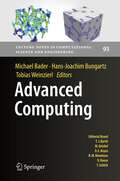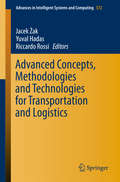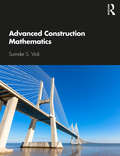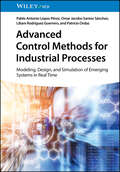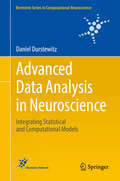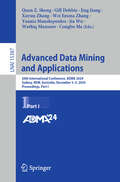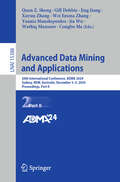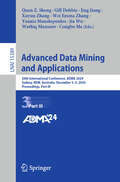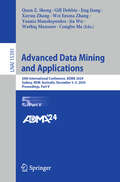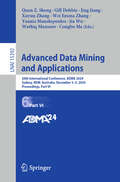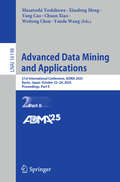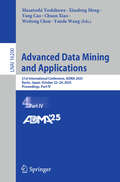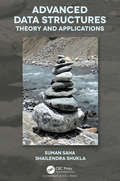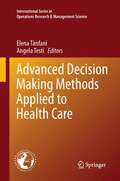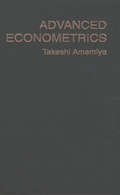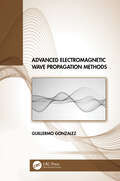- Table View
- List View
Advanced Computing, Machine Learning, Robotics and Internet Technologies: First International Conference, AMRIT 2023, Silchar, India, March 10–11, 2023, Revised Selected Papers, Part II (Communications in Computer and Information Science #1954)
by Rajkumar Buyya Prodipto Das Shahin Ara BegumThis two-volume set constitutes selected papers presented during the First International Conference on Advanced Computing, Machine Learning, Robotics and Internet Technologies, AMRIT 2023, held in Silchar, India, in March 2023.The 20 full papers and 27 short papers presented were thoroughly reviewed and selected from 110 submissions. They cover the following topics: artificial intelligence, machine learning, natural language processing, image processing, data science, soft computing techniques, computer networks and security, computer architecture and algorithms.
Advanced Computing: Accelerating Computational Science And Engineering (cse) (Lecture Notes in Computational Science and Engineering #93)
by Hans-Joachim Bungartz Michael Bader Tobias WeinzierlThis proceedings volume collects review articles that summarize research conducted at the Munich Centre of Advanced Computing (MAC) from 2008 to 2012. The articles address the increasing gap between what should be possible in Computational Science and Engineering due to recent advances in algorithms, hardware, and networks, and what can actually be achieved in practice; they also examine novel computing architectures, where computation itself is a multifaceted process, with hardware awareness or ubiquitous parallelism due to many-core systems being just two of the challenges faced. Topics cover both the methodological aspects of advanced computing (algorithms, parallel computing, data exploration, software engineering) and cutting-edge applications from the fields of chemistry, the geosciences, civil and mechanical engineering, etc. , reflecting the highly interdisciplinary nature of the Munich Centre of Advanced Computing.
Advanced Concepts, Methodologies and Technologies for Transportation and Logistics (Advances in Intelligent Systems and Computing #572)
by Riccardo Rossi Jacek Żak Yuval HadasThis book is a collection of original papers produced by the members of the Euro Working Group on Transportation (EWGT) in the last several years (2015-2017). The respective chapters present the results of various research projects carried out by the members of the EWGT and extended versions of presentations given at the last several meetings of the EWGT. The book offers a representative sampling of the EWGT's research activities and covers the state-of-the-art in quantitative oriented transportation/logistics research. It highlights a range of advanced concepts, methodologies and technologies, divided into four major thematic streams: Multiple Criteria Analysis in Transportation and Logistics; Urban Transportation and City Logistics; Road Safety and Artificial Intelligence and Soft Computing in Transportation and Logistics. The book is intended for academics/researchers, analysts, business consultants, and graduate students who are interested in advanced techniques of mathematical modeling and computational procedures applied in transportation and logistics.
Advanced Construction Mathematics
by Surinder VirdiAdvanced Construction Mathematics covers the range of topics that a student must learn in order to achieve success in Level 3 and 4 mathematics for the Pearson BTEC National and BTEC HNC/HND in Construction, Building Services, and Civil Engineering. Packed with easy to follow examples, its 18 chapters cover algebra (equations, transposition and evaluation of formulae), differentiation, integration, statistics and numerous other core concepts and their application in the construction/civil engineering field. The book explains technical processes before applying mathematical techniques to solve practical problems which gradually build in complexity. Each chapter contains self-test exercises and answers and numerous illustrations to simplify the essential maths required at Levels 3 and 4. The book is also a useful recap or primer for students on BSc or non-cognate MSc Construction and Civil Engineering degrees.
Advanced Control Methods for Industrial Processes: Modeling, Design, and Simulation of Emerging Systems in Real Time
by Pablo A. López-Pérez Omar Jacobo Santos Sánchez Liliam Rodríguez Guerrero Patricio OrdazA detailed introduction to mathematical models for new and established control engineers Control engineering is a system that helps us understand electrical, physical, chemical, and biochemical systems through the use of mathematical modeling, using inputs, outputs, and simulations. These experimental platforms are implemented in most systems of modern advanced control engineering. Advanced Control Methods for Industrial Processes provides a solid grounding in traditional control techniques. It emphasizes practical application methods alongside the underlying theory and core instrumentation. Each chapter discusses the full profile of the technology covered, from the field layer and control layer to its implementation. It also includes the interfaces for advanced control systems: between controllers and systems theory, between different layers, and between operators-systems. Through an emphasis on the practical issues of components, devices, and hardware circuits, the book offers working principles and operation mechanisms that allow an engineer to put theory into practice for the advanced control techniques. Advanced Control Methods for Industrial Processes readers will also find: A practical overview on advanced control methods applied to real-time and in-silico systems Specific parameters, install procedures, calibration and configuration methodologies necessary to conduct the relevant models Clear insights into the necessary mathematical models Tutorial material to facilitate the understanding of core concepts Advanced Control Methods for Industrial Processes is an ideal companion for process engineers, control engineers, and chemists in industry.
Advanced Control and Intelligent Computing Applications: 8th International Conference on Life System Modeling and Simulation, LSMS 2024 and 8th International Conference on Intelligent Computing for Sustainable Energy and Environment, ICSEE 2024, Suzhou, China, September 13–15, 2024, Proceedings, Part IV (Communications in Computer and Information Science #2219)
by Chen Peng Zhi Chen Yulong Wang Yanpeng Guan Qing Sun Yajian ZhangThe five-volume set constitutes the thoroughly refereed proceedings of the 8th International Conference on Life System Modeling and Simulation, LSMS 2024, and of the 8th International Conference on Intelligent Computing for Sustainable Energy and Environment, ICSEE 2024, which were held during September 13-15, in Suzhou, China. The 29 papers presented were carefully reviewed and selected from over 496 submissions. The LSMS and ICSEE international conference series aim to bring together international researchers and practitioners in the fields of advanced methods for life system modeling and simulation, as well as advanced intelligent computing theory, methodologies, and engineering applications in achieving net zero across all sectors to tackle the global climate change challenge.
Advanced Data Analysis in Neuroscience: Integrating Statistical and Computational Models (Bernstein Series in Computational Neuroscience)
by Daniel DurstewitzThis book is intended for use in advanced graduate courses in statistics / machine learning, as well as for all experimental neuroscientists seeking to understand statistical methods at a deeper level, and theoretical neuroscientists with a limited background in statistics. It reviews almost all areas of applied statistics, from basic statistical estimation and test theory, linear and nonlinear approaches for regression and classification, to model selection and methods for dimensionality reduction, density estimation and unsupervised clustering. Its focus, however, is linear and nonlinear time series analysis from a dynamical systems perspective, based on which it aims to convey an understanding also of the dynamical mechanisms that could have generated observed time series. Further, it integrates computational modeling of behavioral and neural dynamics with statistical estimation and hypothesis testing. This way computational models in neuroscience are not only explanat ory frameworks, but become powerful, quantitative data-analytical tools in themselves that enable researchers to look beyond the data surface and unravel underlying mechanisms. Interactive examples of most methods are provided through a package of MatLab routines, encouraging a playful approach to the subject, and providing readers with a better feel for the practical aspects of the methods covered. "Computational neuroscience is essential for integrating and providing a basis for understanding the myriads of remarkable laboratory data on nervous system functions. Daniel Durstewitz has excellently covered the breadth of computational neuroscience from statistical interpretations of data to biophysically based modeling of the neurobiological sources of those data. His presentation is clear, pedagogically sound, and readily useable by experts and beginners alike. It is a pleasure to recommend this very well crafted discussion to experimental neuroscientists as well as mathematically well versed Physicists. The book acts as a window to the issues, to the questions, and to the tools for finding the answers to interesting inquiries about brains and how they function. " Henry D. I. Abarbanel Physics and Scripps Institution of Oceanography, University of California, San Diego "This book delivers a clear and thorough introduction to sophisticated analysis approaches useful in computational neuroscience. The models described and the examples provided will help readers develop critical intuitions into what the methods reveal about data. The overall approach of the book reflects the extensive experience Prof. Durstewitz has developed as a leading practitioner of computational neuroscience. " Bruno B. Averbeck
Advanced Data Mining and Applications: 20th International Conference, ADMA 2024, Sydney, NSW, Australia, December 3–5, 2024, Proceedings, Part I (Lecture Notes in Computer Science #15387)
by Quan Z. Sheng Yannis Manolopoulos Gill Dobbie Xuyun Zhang Wei Emma Zhang Jing Jiang Jia Wu Wathiq Mansoor Congbo MaThis six-volume set, LNAI 15387-15392, constitutes the refereed proceedings of the 20th International Conference on Advanced Data Mining and Applications, ADMA 2024, held in Sydney, New South Wales, Australia, during December 3–5, 2024. The 159 full papers presented here were carefully reviewed and selected from 422 submissions. These papers have been organized under the following topical sections across the different volumes: - Part I : Applications; Data mining. Part II : Data mining foundations and algorithms; Federated learning; Knowledge graph. Part III : Graph mining; Spatial data mining. Part IV : Health informatics. Part V : Multi-modal; Natural language processing. Part VI : Recommendation systems; Security and privacy issues.
Advanced Data Mining and Applications: 20th International Conference, ADMA 2024, Sydney, NSW, Australia, December 3–5, 2024, Proceedings, Part II (Lecture Notes in Computer Science #15388)
by Quan Z. Sheng Yannis Manolopoulos Gill Dobbie Xuyun Zhang Wei Emma Zhang Jing Jiang Jia Wu Wathiq Mansoor Congbo MaThis six-volume set, LNAI 15387-15392, constitutes the refereed proceedings of the 20th International Conference on Advanced Data Mining and Applications, ADMA 2024, held in Sydney, New South Wales, Australia, during December 3–5, 2024. The 159 full papers presented here were carefully reviewed and selected from 422 submissions. These papers have been organized under the following topical sections across the different volumes: - Part I : Applications; Data mining. Part II : Data mining foundations and algorithms; Federated learning; Knowledge graph. Part III : Graph mining; Spatial data mining. Part IV : Health informatics. Part V : Multi-modal; Natural language processing. Part VI : Recommendation systems; Security and privacy issues.
Advanced Data Mining and Applications: 20th International Conference, ADMA 2024, Sydney, NSW, Australia, December 3–5, 2024, Proceedings, Part III (Lecture Notes in Computer Science #15389)
by Quan Z. Sheng Yannis Manolopoulos Gill Dobbie Xuyun Zhang Wei Emma Zhang Jing Jiang Jia Wu Wathiq Mansoor Congbo MaThis six-volume set, LNAI 15387-15392, constitutes the refereed proceedings of the 20th International Conference on Advanced Data Mining and Applications, ADMA 2024, held in Sydney, New South Wales, Australia, during December 3–5, 2024. The 159 full papers presented here were carefully reviewed and selected from 422 submissions. These papers have been organized under the following topical sections across the different volumes: - Part I : Applications; Data mining. Part II : Data mining foundations and algorithms; Federated learning; Knowledge graph. Part III : Graph mining; Spatial data mining. Part IV : Health informatics. Part V : Multi-modal; Natural language processing. Part VI : Recommendation systems; Security and privacy issues.
Advanced Data Mining and Applications: 20th International Conference, ADMA 2024, Sydney, NSW, Australia, December 3–5, 2024, Proceedings, Part IV (Lecture Notes in Computer Science #15390)
by Quan Z. Sheng Yannis Manolopoulos Gill Dobbie Xuyun Zhang Wei Emma Zhang Jing Jiang Jia Wu Wathiq Mansoor Congbo MaThis six-volume set, LNAI 15387-15392, constitutes the refereed proceedings of the 20th International Conference on Advanced Data Mining and Applications, ADMA 2024, held in Sydney, New South Wales, Australia, during December 3–5, 2024. The 159 full papers presented here were carefully reviewed and selected from 422 submissions. These papers have been organized under the following topical sections across the different volumes: - Part I : Applications; Data mining. Part II : Data mining foundations and algorithms; Federated learning; Knowledge graph. Part III : Graph mining; Spatial data mining. Part IV : Health informatics. Part V : Multi-modal; Natural language processing. Part VI : Recommendation systems; Security and privacy issues.
Advanced Data Mining and Applications: 20th International Conference, ADMA 2024, Sydney, NSW, Australia, December 3–5, 2024, Proceedings, Part V (Lecture Notes in Computer Science #15391)
by Quan Z. Sheng Yannis Manolopoulos Gill Dobbie Xuyun Zhang Wei Emma Zhang Jing Jiang Jia Wu Wathiq Mansoor Congbo MaThis six-volume set, LNAI 15387-15392, constitutes the refereed proceedings of the 20th International Conference on Advanced Data Mining and Applications, ADMA 2024, held in Sydney, New South Wales, Australia, during December 3–5, 2024. The 159 full papers presented here were carefully reviewed and selected from 422 submissions. These papers have been organized under the following topical sections across the different volumes: - Part I : Applications; Data mining. Part II : Data mining foundations and algorithms; Federated learning; Knowledge graph. Part III : Graph mining; Spatial data mining. Part IV : Health informatics. Part V : Multi-modal; Natural language processing. Part VI : Recommendation systems; Security and privacy issues.
Advanced Data Mining and Applications: 20th International Conference, ADMA 2024, Sydney, NSW, Australia, December 3–5, 2024, Proceedings, Part VI (Lecture Notes in Computer Science #15392)
by Quan Z. Sheng Yannis Manolopoulos Gill Dobbie Xuyun Zhang Wei Emma Zhang Jing Jiang Jia Wu Wathiq Mansoor Congbo MaThis six-volume set, LNAI 15387-15392, constitutes the refereed proceedings of the 20th International Conference on Advanced Data Mining and Applications, ADMA 2024, held in Sydney, New South Wales, Australia, during December 3–5, 2024. The 159 full papers presented here were carefully reviewed and selected from 422 submissions. These papers have been organized under the following topical sections across the different volumes: - Part I : Applications; Data mining. Part II : Data mining foundations and algorithms; Federated learning; Knowledge graph. Part III : Graph mining; Spatial data mining. Part IV : Health informatics. Part V : Multi-modal; Natural language processing. Part VI : Recommendation systems; Security and privacy issues.
Advanced Data Mining and Applications: 21st International Conference, ADMA 2025, Kyoto, Japan, October 22–24, 2025, Proceedings, Part I (Lecture Notes in Computer Science #16197)
by Yang Cao Xiaofeng Meng Chuan Xiao Weitong Chen Masatoshi Yoshikawa Yanda WangThis five-volume set, constitutes the refereed proceedings of the 21st International Conference on Advanced Data Mining and Applications, ADMA 2025, held in Kyoto, Japan, during October 22–24, 2025.
Advanced Data Mining and Applications: 21st International Conference, ADMA 2025, Kyoto, Japan, October 22–24, 2025, Proceedings, Part II (Lecture Notes in Computer Science #16198)
by Yang Cao Xiaofeng Meng Chuan Xiao Weitong Chen Masatoshi Yoshikawa Yanda WangThis five-volume set, constitutes the refereed proceedings of the 21st International Conference on Advanced Data Mining and Applications, ADMA 2025, held in Kyoto, Japan, during October 22–24, 2025.
Advanced Data Mining and Applications: 21st International Conference, ADMA 2025, Kyoto, Japan, October 22–24, 2025, Proceedings, Part IV (Lecture Notes in Computer Science #16200)
by Yang Cao Xiaofeng Meng Chuan Xiao Weitong Chen Masatoshi Yoshikawa Yanda WangThis five-volume set, constitutes the refereed proceedings of the 21st International Conference on Advanced Data Mining and Applications, ADMA 2025, held in Kyoto, Japan, during October 22–24, 2025.
Advanced Data Science and Analytics with Python (Chapman & Hall/CRC Data Mining and Knowledge Discovery Series)
by Jesus Rogel-SalazarAdvanced Data Science and Analytics with Python enables data scientists to continue developing their skills and apply them in business as well as academic settings. The subjects discussed in this book are complementary and a follow-up to the topics discussed in Data Science and Analytics with Python. The aim is to cover important advanced areas in data science using tools developed in Python such as SciKit-learn, Pandas, Numpy, Beautiful Soup, NLTK, NetworkX and others. The model development is supported by the use of frameworks such as Keras, TensorFlow and Core ML, as well as Swift for the development of iOS and MacOS applications. Features: Targets readers with a background in programming, who are interested in the tools used in data analytics and data science Uses Python throughout Presents tools, alongside solved examples, with steps that the reader can easily reproduce and adapt to their needs Focuses on the practical use of the tools rather than on lengthy explanations Provides the reader with the opportunity to use the book whenever needed rather than following a sequential path The book can be read independently from the previous volume and each of the chapters in this volume is sufficiently independent from the others, providing flexibility for the reader. Each of the topics addressed in the book tackles the data science workflow from a practical perspective, concentrating on the process and results obtained. The implementation and deployment of trained models are central to the book. Time series analysis, natural language processing, topic modelling, social network analysis, neural networks and deep learning are comprehensively covered. The book discusses the need to develop data products and addresses the subject of bringing models to their intended audiences – in this case, literally to the users’ fingertips in the form of an iPhone app. About the Author Dr. Jesús Rogel-Salazar is a lead data scientist in the field, working for companies such as Tympa Health Technologies, Barclays, AKQA, IBM Data Science Studio and Dow Jones. He is a visiting researcher at the Department of Physics at Imperial College London, UK and a member of the School of Physics, Astronomy and Mathematics at the University of Hertfordshire, UK.
Advanced Data Structures: Theory and Applications
by Suman Saha Shailendra ShuklaAdvanced data structures is a core course in Computer Science which most graduate program in Computer Science, Computer Science and Engineering, and other allied engineering disciplines, offer during the first year or first semester of the curriculum. The objective of this course is to enable students to have the much-needed foundation for advanced technical skill, leading to better problem-solving in their respective disciplines. Although the course is running in almost all the technical universities for decades, major changes in the syllabus have been observed due to the recent paradigm shift of computation which is more focused on huge data and internet-based technologies. Majority of the institute has been redefined their course content of advanced data structure to fit the current need and course material heavily relies on research papers because of nonavailability of the redefined text book advanced data structure. To the best of our knowledge well-known textbook on advanced data structure provides only partial coverage of the syllabus. The book offers comprehensive coverage of the most essential topics, including: Part I details advancements on basic data structures, viz., cuckoo hashing, skip list, tango tree and Fibonacci heaps and index files. Part II details data structures of different evolving data domains like special data structures, temporal data structures, external memory data structures, distributed and streaming data structures. Part III elucidates the applications of these data structures on different areas of computer science viz, network, www, DBMS, cryptography, graphics to name a few. The concepts and techniques behind each data structure and their applications have been explained. Every chapter includes a variety of Illustrative Problems pertaining to the data structure(s) detailed, a summary of the technical content of the chapter and a list of Review Questions, to reinforce the comprehension of the concepts. The book could be used both as an introductory or an advanced-level textbook for the advanced undergraduate, graduate and research programmes which offer advanced data structures as a core or an elective course. While the book is primarily meant to serve as a course material for use in the classroom, it could be used as a starting point for the beginner researcher of a specific domain.
Advanced Decision Making Methods Applied to Health Care (International Series in Operations Research & Management Science #173)
by Angela Testi Elena TanfaniThe most difficult part of making decisions in the health care field on all levels (national, regional, institutional, patient) is linked to the very complexity of the system itself, to the intrinsic uncertainty involved and its dynamic nature. This requires not only the ability to analyze and interpret a large amount of information but also arrange it so that it becomes a cognitive base for appropriate decision-making. Moreover, decisions in the health care field are subjected to many challenges and constraints: fast change and uncertain outcomes, aging population, increasing citizen expectations, equity considerations and limited resources. Operations research, statistical and economic-related quantitative methods supply these decisions making tools and methodology. The contributed book presents a collection of applications to concrete situations detailing the problem area, the methodology employed, the implementation and results. Each topic addressed in the book will be structured in such a way that an interdisciplinary and wide audience will be able to use the materials presented. As an example the book chapters will address health policies issues, planning health services, epidemiology and disease modelling, home-care modelling, logistics in health care, capacity planning, quality and appropriateness.
Advanced Differential Quadrature Methods (Chapman & Hall/CRC Applied Mathematics & Nonlinear Science)
by Zhi Zong Yingyan ZhangModern Tools to Perform Numerical DifferentiationThe original direct differential quadrature (DQ) method has been known to fail for problems with strong nonlinearity and material discontinuity as well as for problems involving singularity, irregularity, and multiple scales. But now researchers in applied mathematics, computational mechanics, and en
Advanced Econometric Theory (Routledge Advanced Texts in Economics and Finance)
by John ChipmanWhen learning econometrics, what better way than to be taught by one of its masters. In this significant new volume, John Chipman, the eminence grise of econometrics, presents his classic lectures in econometric theory. Starting with the linear regression model, least squares, Gauss-Markov theory and the first principals of econometrics, this book guides the introductory student to an advanced stage of ability. The text covers multicollinearity and reduced-rank estimation, the treatment of linear restrictions and minimax estimation. Also included are chapters on the autocorrelation of residuals and simultaneous-equation estimation. By the end of the text, students will have a solid grounding in econometrics. Despite the frequent complexity of the subject matter, Chipman's clear explanations, concise prose and sharp analysis make this book stand out from others in the field. With mathematical rigor sharpened by a lifetime of econometric analysis, this significant volume is sure to become a seminal and indispensable text in this area.
Advanced Econometrics
by Takeshi AmemiyaAdvanced Econometrics is both a comprehensive text for graduate students and a reference work for econometricians. It will also be valuable to those doing statistical analysis in the other social sciences. Its main features are a thorough treatment of cross-section models, including qualitative response models, censored and truncated regression models, and Markov and duration models, as well as a rigorous presentation of large sample theory, classical least-squares and generalized least-squares theory, and nonlinear simultaneous equation models. <P><P> Although the treatment is mathematically rigorous, the author has employed the theorem-proof method with simple, intuitively accessible assumptions. This enables readers to understand the basic structure of each theorem and to generalize it for themselves depending on their needs and abilities. Many simple applications of theorems are given either in the form of examples in the text or as exercises at the end of each chapter in order to demonstrate their essential points.
Advanced Electromagnetic Models for Materials Characterization and Nondestructive Evaluation (Scientific Computation)
by Elias H. Sabbagh Harold A Sabbagh R. Kim Murphy Liming Zhou Russell WincheskiThis book expands on the subject matter of ’Computational Electromagnetics and Model-Based Inversion: A Modern Paradigm for Eddy-Current Nondestructive Evaluation.’ It includes (a) voxel-based inversion methods, which are generalizations of model-based algorithms; (b) a complete electromagnetic model of advanced composites (and other novel exotic materials), stressing the highly anisotropic nature of these materials, as well as giving a number of applications to nondestructive evaluation; and (c) an up-to-date discussion of stochastic integral equations and propagation-of-uncertainty models in nondestructive evaluation. As such, the book combines research started twenty-five years ago in advanced composites and voxel-based algorithms, but published in scattered journal articles, as well as recent research in stochastic integral equations. All of these areas are of considerable interest to the aerospace, nuclear power, civil infrastructure, materials characterization and biomedical industries. The book covers the topic of computational electromagnetics in eddy-current nondestructive evaluation (NDE) by emphasizing three distinct topics: (a) fundamental mathematical principles of volume-integral equations as a subset of computational electromagnetics, (b) mathematical algorithms applied to signal-processing and inverse scattering problems, and (c) applications of these two topics to problems in which real and model data are used. It is therefore more than an academic exercise and is valuable to users of eddy-current NDE technology in industries as varied as nuclear power, aerospace, materials characterization and biomedical imaging.
Advanced Electromagnetic Wave Propagation Methods
by Guillermo GonzalezThis textbook provides a solid foundation into many approaches that are used in the analysis of advanced electromagnetic wave propagation problems. The techniques discussed are essential to obtain closed-form solutions or asymptotic solutions and meet an existing need for instructors and students in electromagnetic theory. The book covers various advanced mathematical methods used in the evaluation of the electromagnetic fields in rectangular, cylindrical and spherical geometries. The mathematics of special functions (i.e., Bessel, Hankel, Airy, Legendre, Error, etc.) are covered in depth, including appropriate Appendices. The author takes particular care to provide detailed explanations of auxiliary potentials, Hertz’s vectors, Debye potentials, as well as the use of Green functions, the Watson transformation and the method of steepest descent in the solution of electromagnetic problems. Overall, Advanced Electromagnetic Wave Propagation Methods is a good source for the many skills required in obtaining closed form and asymptotic solution, which in many instances cannot be obtained using computer codes of Maxwell’s equations. Thus, it provides an excellent training for preparing graduate students in their research work. This book is intended for a graduate course in electromagnetic theory for students in electrical engineering. Students in physics and professionals will also find it appropriate and useful. Provides a comprehensive and unified treatment of radiation and propagation problems Presents a detailed explanation in the use of Green functions, the Watson transformation and the method of steepest descent as they apply to electromagnetic problems Demonstrates various advanced mathematical techniques used in the evaluation of the electromagnetic fields Details how to formulate and obtain a closed-form solution or an asymptotic solution Includes appendices for Bessel, Legendre, Airy and Error functions
Advanced Engineering Mathematics
by Lawrence TurynBeginning with linear algebra and later expanding into calculus of variations, Advanced Engineering Mathematics provides accessible and comprehensive mathematical preparation for advanced undergraduate and beginning graduate students taking engineering courses. This book offers a review of standard mathematics coursework while effectively integrati

